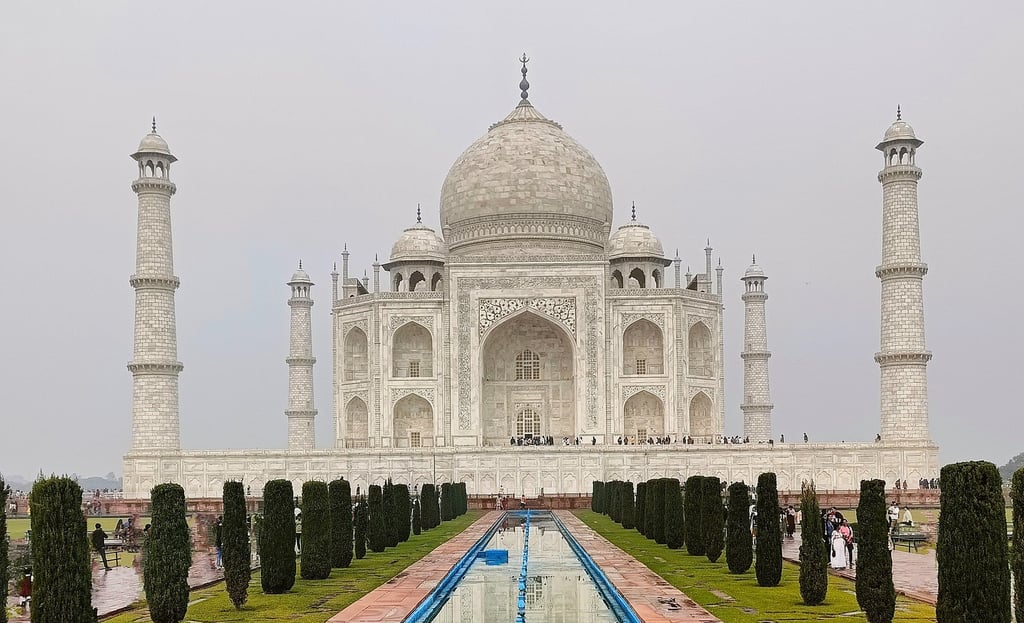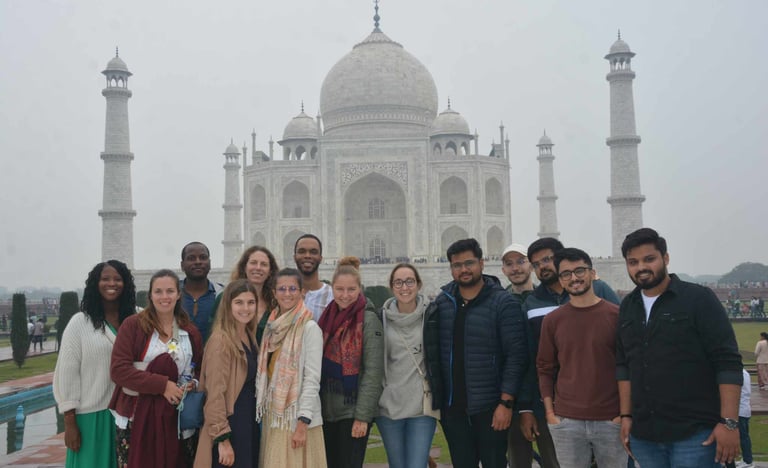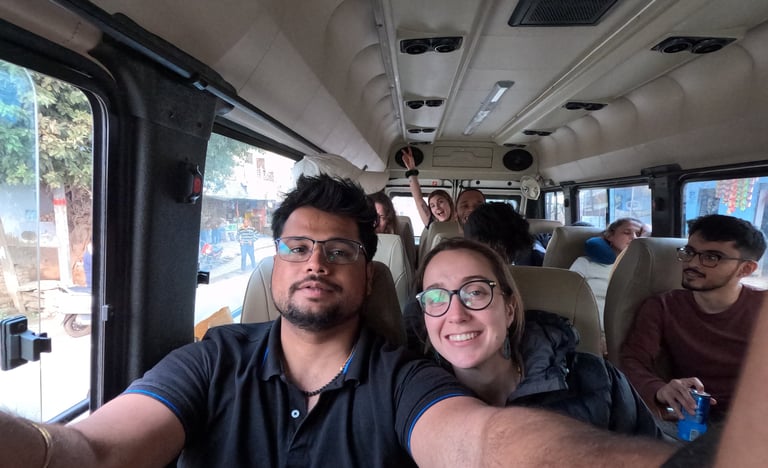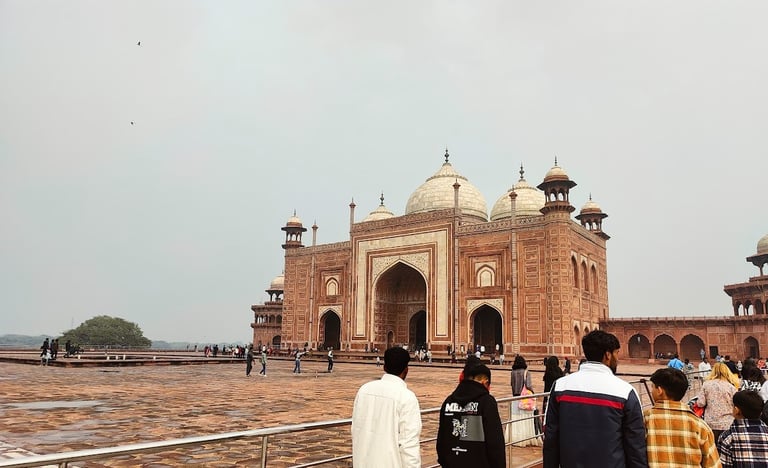A Magical Experience at the Taj Mahal
A personal account of visiting the Taj Mahal with a group of international friends. This section shares what it truly feels like to see the monument in person, along with practical advice for first-time visitors, from tickets and entry to what to expect once you're inside.
Mihir Panvalkar
10/12/2025


My Experince
If you're heading to India and wondering whether the Taj Mahal is really worth all the effort, the travel, and the crowds... my honest opinion? Yes, it absolutely is. No photo, no drone shot, no postcard can prepare you for the moment you see it with your own eyes. The building is everywhere online, sure, but standing in front of it is something else entirely. It’s quieter than you expect. Slower. Almost unreal.The Taj Mahal, as most know, was built by Emperor Shah Jahan in memory of his wife Mumtaz Mahal, who passed away in 1631. But beyond its history, what really strikes you is how soft it feels. Not fragile, but gentle. The kind of beauty that doesn’t demand your attention, but quietly holds it.
Our group started from Jaipur early in the morning. There were sixteen of us in total, twelve international friends and four Indians. We had rented a tempo traveller and began the five-hour drive in heavy rain. Honestly, I was nervous. I kept looking at the weather, wondering if this was going to be one of those trips where everything goes wrong. For many in our group, this was their one chance to see the Taj. I didn’t want them to leave disappointed. And then, just as we reached Agra, the rain stopped. The air felt cooler. The smog that usually hangs over the city seemed to settle. And there it was, the Taj Mahal, perfectly visible. It almost felt planned.
The ticket prices vary depending on where you're from. Indian citizens pay just 50 rupees, while foreign nationals pay around 1100. If you want to go inside the mausoleum, that’s an additional 200. With your ticket, they give you a small bottle of water and shoe covers, which you need to wear if you go inside. Because of the pollution in the area, regular vehicles aren’t allowed near the monument. From the parking area, you can either walk or take a battery-powered shuttle, which is included in your ticket. We chose to walk. The path is lined with souvenir shops, tea stalls, small hotels and quiet excitement. You get small glimpses of the domes between buildings, and each step forward feels a little more surreal.
When we reached the gate, we had to go through security checks. It’s strict. Keep your passport ready. There are separate lines for men and women. Foreigners get a slightly faster lane because of the higher ticket cost, but it’s still a process. You’re not allowed to carry large bags, food, books, pens, tripods, or even lipstick. It’s best to carry only what you really need, a phone or camera, your passport, some money, and water. Free locker facilities are available, but lighter is better.
Outside the entrance, you’ll find a lot of guides offering their services. Some are official, some are not. If you plan to take a guide, make sure they have a government-approved license. We didn’t take one. Sometimes it's better to take it in on your own terms, without too much being said. Once we stepped through the final gate, the monument appeared in full. No fog, no rain. Just clear white marble set against a soft grey sky. Everyone in our group went quiet. Even those who had been before paused again. It just has that effect.
I’ve grown up in India, and like many Indians, I’ve seen countless images of the Taj Mahal. It’s printed on school notebooks, shown in movies, used in ads. But none of that prepared me for how peaceful it felt in person. Despite the crowd, it didn’t feel loud. It felt balanced. Graceful. In its symmetry, you sense the care that went into every detail.
We stayed there longer than planned. No one was in a rush to leave. Some of us just sat quietly. Others walked around the gardens. The whole place encourages stillness. And in that stillness, something about the monument begins to speak not in words, of course, but in space, in presence. Travel however long it takes. Stand in the security line. Walk the last stretch. Carry your water bottle and wear the silly shoe covers. It’s worth it. Some places really are as magical as they say. This was one of them.
While most people rush to see the marble wonder, don't miss the other structures inside the complex. On one side, there's the mosque where prayers are still held on Fridays. And on the opposite side stands the Jawab Masjid, a perfectly symmetrical building made of red sandstone.




Practical Guide for International Visitors
If you're visiting the Taj Mahal as a foreign traveler, especially for the first time, here are a few tips to help you avoid the common mistakes and get the most out of your trip
How to Get There:
We traveled from Jaipur in a tempo traveler, but you can also come from Delhi or Varanasi by train or car. From Delhi, it takes about 3–4 hours by road or 2 hours via the Gatimaan Express train. Agra is well connected, but traffic and weather can always add some uncertainty.
Ticket Info (Updated as of 2024):
Foreign Nationals: ₹1100
SAARC & BIMSTEC Nationals: ₹540
Indian Citizens: ₹50
Entry to the Mausoleum (optional): ₹200 extra
You’ll get a small bottle of water and shoe covers with your ticket. Buy tickets online in advance if you can, or go early — lines can build up by mid-morning.
Gates and Entry Strategy:
There are three gates: East, West, and South.
East Gate is best for early entry but usually has the longest queues.
West Gate is slightly less crowded and convenient for car access.
South Gate is currently for exit only.
Polluting vehicles are banned within 500 meters. You can walk or take the included electric shuttle from the parking area. We walked from the East Gate, which added a nice buildup to the visit.
Security and What to Carry:
Have your passport ready. You’ll need it at both the ticket counter and security.
Separate queues for men and women.
Don’t carry large bags. Lockers are available, but light travel makes it easier.
Avoid carrying food, books, pens, lighters, lipstick, or any cosmetics. Most of it will be confiscated.
Tripods are not allowed.
Bring only your essentials: camera or phone, wallet, water, and ID.
Do You Need a Guide?
The moment you get close to the gate, local guides will start offering their services. Some are legitimate, some are not. Official guides wear IDs and can be hired on the spot, but if you want a more curated experience — especially in your language — it's better to book through a travel agency in advance. Our group decided to a english guide and also took time to explore at our own pace, which worked really well for us.
Best Time to Visit:
Go early, right when the gates open (around sunrise). Fewer people, cooler weather, better light.
Avoid visiting on Fridays, when the Taj is closed.
Post-rain (like our experience) often brings out the best visibility and cooler air.
If you’re planning the visit, plan it well — but don’t over-plan it. Let the day carry you a little. That’s where the real magic is.


